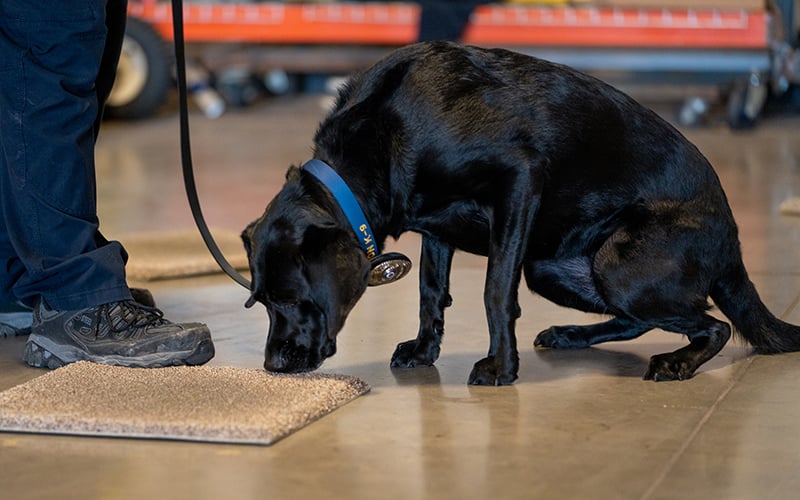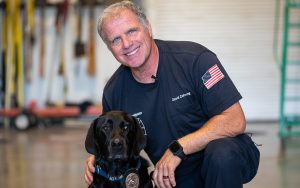GILBERT – “Who … is … going … to … jail … today?”
Gilbert fire investigator David Zehring is addressing Zeta, his black Labrador retriever, as he points back and forth to my hands. Hidden in my right hand is a piece of wood with a single drop of lighter fluid on it.
Zehring is the fire investigator for Gilbert Fire and Rescue, and Zeta is trained to detect arson.
“Who … is … going … to … jail … today?”
Zeta, who’s 4, points her nose at my right hand, where the wood is tucked between my fingers.
“You are!” Zehring tells me as he feeds Zeta a treat.
Zeta trains twice a day as an accelerant detection canine for the federal Bureau of Alcohol, Tobacco, Firearms and Explosives. She’s the only such dog in Arizona, and has solved 95 arson cases.
In just 20 minutes, Zeta can determine the cause of a fire, something that can take investigators hours or days.
Zeta can detect and signal minute traces of six fire accelerants. She sits when she smells an accelerant and then “shows,” or puts her nose on the exact spot where the accelerant is.
As a member of Gilbert Fire and Rescue, Zeta wears a police badge on her collar. For Zehring, who owns Zeta, this means he gets to bring his dog to work everyday.
“Even though she is an accelerant canine, she brings a lot of enjoyment to our office,” he said. “Somebody could be having a bad day and she comes in and just lightens the atmosphere, and that’s a benefit.”

Zeta sniffs carpet for fire accelerants as part of her daily training in Gilbert. (Photo by Samantha Chow/Cronkite News)
Why does Arizona have an ATF canine?
Zehring joined the ATF accelerant detection canine program in 2012 after an arson canine came from Oregon to investigate a large fire at the Church of Jesus Christ of Latter Day Saints meeting house in Tolleson.
Firefighters suspected arson because of the fire’s heat and speed, which destroyed the brick structure. After the fire, ATF officials determined Arizona needed an arson dog.
There were no ATF dogs in the Southwest at the time. The Maricopa County Fire Investigation Task Force nominated Zehring in 2012 to be the dog’s handler.
The ATF made special accommodations for Zehring to get his training done three months after the nomination – a quick turnaround, as the ATF usually takes one to two years before approving a fire department for the canine program. Zehring’s first dog, Spring, retired in 2019. She is living out her retirement with Zehring.
The dogs go through more training than the handlers.
“Dogs go to ATF (Front Royal, Virginia) six weeks prior to the handler,” he said. “So in those six weeks, the canines are imprinted on ignitable liquids.”
Cody Monday, with the ATF’s Phoenix field division, said the imprinting process is fairly simple.
“You have the dog sniff the accelerant and then pay it with food,” he said. “Have the dog sniff it and you do that approximately 80 to 100 times per day for the first week.”
Once the dog sniffs the accelerant and looks to the handler for food, Monday said, the dog is trained to sit. Instructors then introduce the dog to different types of accelerants.
After these six weeks of imprinting and training, the handlers show up and the dogs are assigned to trainees based on their personality.
“The instructors have an opportunity to get to know the handlers, and then that’s when they do their placements,” Zehring said. “They don’t just walk in and say, ‘OK, you’re taking this dog.’ They are going to assess to see what would be best for each handler.”
Monday, who trained dog handlers for seven years, said he sent handlers a questionnaire before they arrived. Before making assignments, he would consider their living situation, if they had a dog, or whether they were married or had kids.

Zeta, an accelerant-detection dog for the federal Bureau of Alcohol, Tobacco, Firearms and Explosives, sniffs T-shirts for fire accelerants during her daily training. (Photo by Samantha Chow/Cronkite News)
What’s behind the program
The bureau’s accelerant-detection canine program began in Connecticut in the early 1990s in conjunction with the ATF, the Connecticut State Police and the federal Office of Antiterrorism Assistance.
“There was obviously a need for something of that caliber to be used, especially in the Northeast, where a lot of the homes are really old,” Monday said. “If somebody wanted to commit an act of arson, we needed to find the best tool to do that with.”
Labrador retrievers turned out to be the best tool. Monday said Labs have an excellent nose and are a hearty and friendly breed who “just want to lick you to death.”
Most of the ATF’s dogs come from Puppies Behind Bars – a New York nonprofit. Prisoners raise and train the dogs to do tasks the ATF wants, such as jumping onto things and investigating them.
After two years, the dogs are sent to the ATF to begin the imprinting process. Once handlers and their dogs are trained, there’s a written exam and a field test to get certified. Zeta joined Gilbert Fire and Rescue in December, 2019. She is one of only 50 ATF arson dogs in the U.S.
What makes Zeta unique
Zeta travels around the country helping fire departments investigate possible arson. She flies first class because of her status as a government agent.

Gilbert fire investigator David Zehring poses with Zeta, an accelerant-detection canine for the ATF. Zehring is the only person who’s allowed to handle Zeta during arson investigations. (Photo by Samantha Chow/Cronkite News)
Her ability to precisely locate accelerants also helps convict offenders.
Zehring said he will group possible arson suspects together and then have Zeta smell each of them. When Zeta “shows,” Zehring said the suspect will either admit to lighting the fire or will get caught later when their clothes are tested for accelerants.
Although Zeta’s job is to investigate fires, she does get to play – and she loves people, Zehring said.
“Zeta was released from being a guide dog or a service animal because she was way too friendly,” he said. “She just loved people way too much.”
Zehring said his food reward system helped Zeta succeed as an ATF arson dog. Zeta only eats from Zehring’s hand when she trains, so she tunes out distractions to get rewarded.
“When I go to work her, she is able to shut down and say, ‘Now you’re invisible, and I have a job to do,’” Zehring said. “That’s the food reward program. She wants to work for that food. She wants to please me.”
Her love of people also makes her incredibly popular among Gilbert firefighters and police officers.
“We all love her,” said Julie Howe, human resource receptionist with Gilbert Fire and Rescue. “She comes in happy and comes up and greets everybody and we love her. I can’t have a dog where I live, so she fills a need for me having a dog.”
Zehring said Zeta also helps Gilbert Fire and Rescue employees relax.
“We always say she’s not trained to be a therapy canine, but there are so many people that look at her as a therapy canine because of her unconditional love,” he said. “It’s almost like she seems to know who is having a bad day and will brighten their day.”

Gilbert fire investigator David Zehring burns cardboard and T-shirts to simulate a fire investigation for Zeta, his arson dog. The black Labrador trains twice a day – even on holidays. (Photo by Samantha Chow/Cronkite News)
What’s the program’s future
Zehring plans to retire in 2025, when Zeta has completed her five to seven years of service. That way, he said, he’ll have the most people attend his retirement out of anyone in police or fire.
“I thought, ‘If I could get Zeta to retire with me, I could say that I had the most people,” Zehring said. “But it’s (a banner) going to say ‘Congratulations, Zeta,’ and my name will probably be at the bottom. But I can still say that a lot of people showed up to my retirement.”
When Zehring retires, Arizona will be without an arson dog. He’s trying to find someone who can replace him, but that’s challenging because Arizona requires handlers to be fire investigators and sworn peace officers, which is a difficult combination to find in Arizona.
The ATF also wants its dogs to retire at age 8, which creates another challenge in finding replacement dogs.
“We usually retire our dogs when they’re 8 years old so they can live out an actual retirement,” Monday said. “They’ve given so much to the country or the city that they work in. We at ATF believe they should have an actual retirement.”
The other fire investigator for Gilbert Fire and Rescue wants to follow Zehring’s path, but his daughter is allergic to dogs. Zehring said a replacement needs to be found soon.
“We need to start making plans because it could take three to four years before (new handlers) are accepted,” he said.
If no replacements are found, then Arizona will lose a popular service member and a time-saving investigator.



